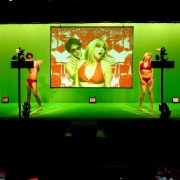Work
/by Big Art GroupBroke House (NYC Premier) – the residents of a house and their hangers-on, once a documentary filmmaker arrives to capture their lives. On a skeletal set webbed with video cameras, the characters try to recall their given roles as inevitably the foundations of their dreams collapse, and they are thrown into the desert of their own futures. Part comedy, part ritual, part love spell. The Performance explores the process of construction, when that process becomes sharply interrupted by historical events, and dissolves into the shapelessness of an aftermath. Those processes that were “building” previous to the play’s beginning include a life, a family, architecture, or a system of beliefs, an economy of values, and the creation of the performance itself. But when events intervene— events like collapse, upheaval, disaster, abandonment, forgetting, fear, and strife— all the raw materials and the players themselves become deformed into a new formlessness, and enter a transitional state of potentiality. Like the pause loop in a video game, Broke House takes place in this marginal time zone.
Opacity 2017 (Workshop Presentation)– A lone character lies in their bedroom, swiping the phone in search of contact. They renovate their online persona with a friend, receive an invitation from a stranger, and arrange for an evening together. As the night deepens, communications obstruct, destinations evade, and attempts at intimacy unmask a profound and insurmountable corruption. Opacity is a dark reflection on the new strategies of connection, reverberating with dread, oddness, and seduction as it advances through its own inexorable and absurd logic.
CITYRAMA (2010) is a performance created in collaboration with the students of HKB and the indipendant artists of Teatro Stabile of Torino, installed and performed at the Castello di Rivoli. CITYRAMA comprises a site-based theatrical and video installation that functions as a performance machine, asking the actor/participant to respond on stage to a flood of stimuli and make split-second responses in the context of a fragmented live movie. Multi-threaded stories, overlapping emotions, and conceptual actions that call attention to the physical occupation of the space combine into a portrait of the living city, of the city as a chimera created of voids and images, human stories and architectural constraints. In the interplay between occupation and transformation, CITYRAMA revels in the struggles of the ordinary hero to create her own world.
SOS (2008-Touring) – began as an investigation into the nature of sacrifice within a supersaturated, hyper-acquisitive society. Set in a forest of technology the performance unwinds through overlapping abstract narratives. Animals lost in their native habitat turn on each other in a hopeless contest for survival. Revolutionaries broadcasting from a skeletal studio implode under the pressure of their own rhetoric, and technology addicts enmeshed in a self-created universe seek escape from a tightening web of perception. As these environments collide and overturn, the stage transforms into a celebration of chaos verging towards the freedom of annihilation.
THE PEOPLE (2007- Serial Project) is a transformation of civil life: an expansion of the experiments of Real Time Film to a panoramic new scale– the conversion of a village into a multi-location video shoot, simultaneously projected & broadcast into the public square; a retelling of the Oresteia in the age of information war and electric vengeance; a counterstrike from the culturally assaulted. The People sprang from an impulse to extend Big Art Group’s experiments in a contemporary language for performance, especially the relationship between communication, images, and actions. The People is realized as a kind of living television; or the re-tooling of commonplace technologies and modes of dialogue (the video clip, the interview, the re-enactment) to invert the established relationship between ‘mass-media’ and private interchange. It reflects new forms of dialogue such as video-sharing sites, blogs, and new technologies— and sculpts these developments into a performative action that takes as its inspiration a foundational idea of community dialogue, the birth of democracy and the role that ‘ordinary’ people perform in self-government. To date, six productions in the series have been presented: The People-Italy, which took place in Polverigi, Italy with the participation and support of Inteatro Polverigi in 2007, The People-Germany, at Theatre der Welt 2008 in Halle, Germany, The People-Austria at Szene Salzburg in 2010, The People – San Francisco with YBCA/Yerba Buena Center for the Arts at Z Space in 2011, and The People – Portland with the Portland Institute of Contemporary Art in 2012
The Imitation (2008-2009) represents Big Art Group’s second foray into the exploration of the Image-Performance, an experimental form that combines visual arts, sampling, and musicianship, merging contemporary visual language with a literary dramaturgy. Combining elements of rock spectacle with the grotesque and avant-garde films of the 1960s, The Imitation tells a cautionary tale about an ambitious artist who comes to the City to advance her career, and meets a financier who becomes possessed by her images. With a set constructed of garbage collected from the streets of New York, The Imitation subverts the relationships between art, commerce, and spectacle.
The Sleep (2007-Touring) is Big Art Group’s first experiment with the Image-Performance, an experimental form that combines visual arts, sampling, and musicianship, merging contemporary visual language with a deep literary dramaturgy. For this episode, the narrative of the piece is constructed around M. P. Shiel’s last man story, “The Purple Cloud,” in which a lone explorer races to the North Pole while a poison purple cloud covers the earth. His subsequent return to the remnants of civilization drives him into a crisis of being.
Dead Set (2006 – Serial Project) exists as a sequence of notes : each part consists as an assemblage of modular concepts, that are rearranged for the duration of the individual spectacle. Dead Set #2 and #3 were organized around the topic of the image of trauma. Dead Set#2 was created first in Berlin at the Hebbel Theatre and for Paris at the Festival d’Automne à Paris. Further iterations of the series will involve non-theatrical performances, straight-to-video releases, and commerce.
House of No More (2004 – 2006) is the third and final part of a conceptual trilogy of Real Time Film begun with the works Shelf Life and Flicker. The performance starts with the reenactment of a crime told by a mother who thrusts herself on screen in her quest for her missing child. But simultaneously as this premise unfolds, the performers develop an antithesis– that the story is being faked as it is being created, dispelled at the same moment as it is conjured. As the characters dissolve into this corrupt transmission, becoming ghostly and multiplied across the surface of the “film,” what emerges is not a battle for the ownership of an absolute truth, but a thirst for a satiating lie.
Ficker (2002-2005) uses Big Art Group’s Real Time Film technique of live video projection and split second-choreography to examine the image of violence in this second part of the RTF trilogy. In Flicker, two “movies” collide into each other and bleed onto a single screen. In one narrative, voyeurism and softcore sadomasochism spin out of control, while the B-story follows a group of city friends who find themselves lost in a wilderness that turns mythic and murderous. As the two films intersect, a dark tale of disjunction emerges, exploring the need to comprehend the irreality of death and the everyday presence of violence. A comedy.
Shelf Life (2001 – 2004) is a live action movie on stage, a film in which three desperate characters who inhabit a consumer wasteland become obsessed with an alluring icon. Each tries to possess and mold her in the form of their media-induced desires, even as she uses them as a means to her own consumptive ends. Fueled by jealousy, rage, and betrayal, this “love quadrangle” ignites into a bizarre and tragic struggle over the ownership of happiness.
The Balladeer (2000) mixes song, text, puppetry, dance and vivid, cinematic direction, The Balladeer tells a freeform story of new love and its defeat. The piece becomes a backdrop for an exploration of identity, anguish, desire; by turns empathetic and vulgar. In an ‘adolescent’ work that led directly to the technique of Real Time Film, Big Art Group mixes filmic and televisual ideas with theatrical form to create a unnerving, bizarre hybrid.
Clearcut, Catastrophe! (1999) The tragic entrapment of nostalgia and the futility of escapist fantasies of the future play out in declining and decaying parallel universes of the Maysles Brothers’ documentary “Grey Gardens” and Chekhov’s masterpiece “Three Sisters.” Through experimental structure and task-based choreography, the performers attempt to embody multiple stories that unravel as quickly as they are constructed. Caden Manson / Big Art Group establishes their nonconformist objectives and transgressive techniques in this debut work.
Share this:
- Click to share on Pinterest (Opens in new window) Pinterest
- Click to share on Facebook (Opens in new window) Facebook
- Click to share on X (Opens in new window) X
- Click to share on LinkedIn (Opens in new window) LinkedIn
- Click to share on Telegram (Opens in new window) Telegram
- Click to share on WhatsApp (Opens in new window) WhatsApp
- Click to share on Tumblr (Opens in new window) Tumblr
- Click to email a link to a friend (Opens in new window) Email
- Click to print (Opens in new window) Print
- More

